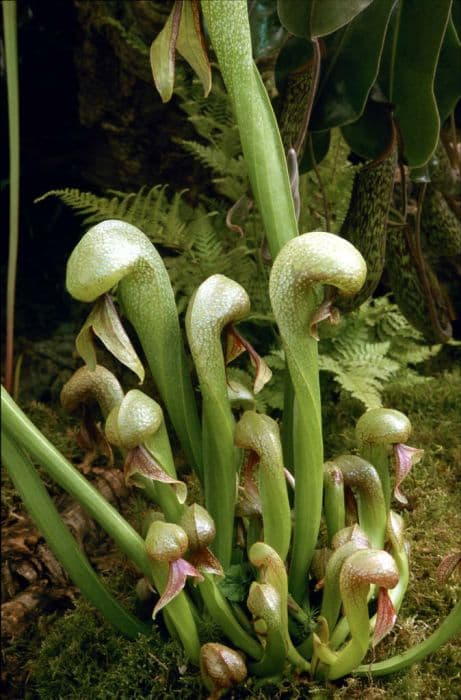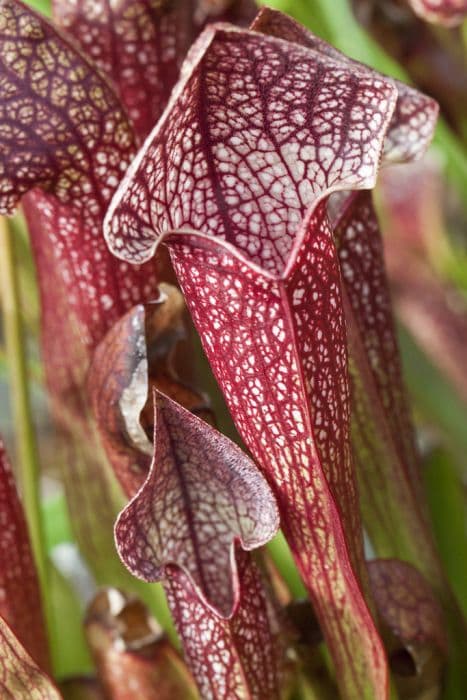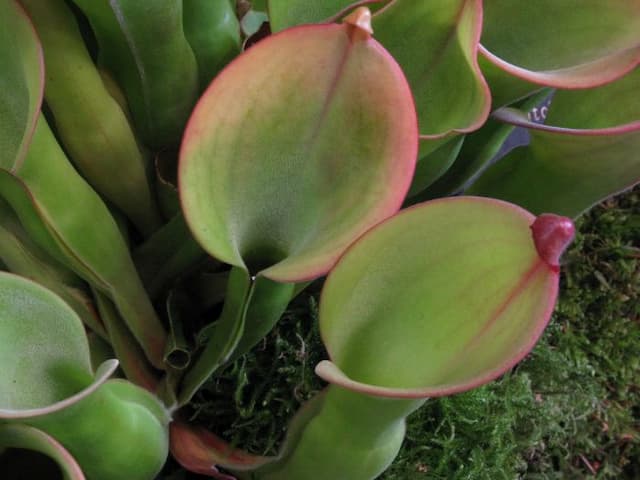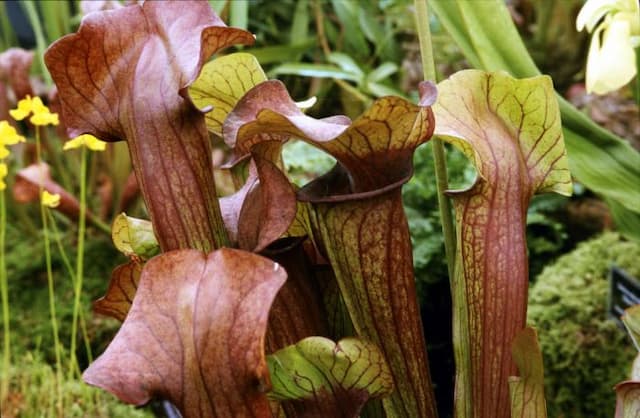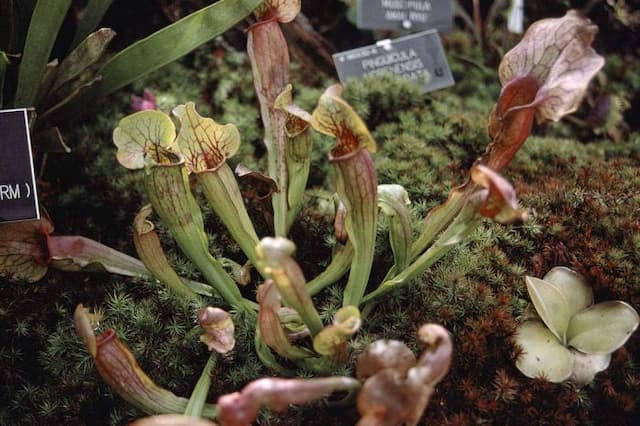Pitcher Plant Sarracenia × moorei 'Brooks's Hybrid'

ABOUT
The Sarracenia × moorei 'Brooks's Hybrid,' commonly known as Brooks Hybrid Pitcher Plant, is adorned with elongated, trumpet-shaped leaves that are designed to attract and trap insects. The pitchers are a fusion of bright and vivid colors, usually integrating shades of green, yellow, red, and purple that can create a striking mottled pattern. This colorful display often includes conspicuous veins that may appear more pronounced against the lighter background colors of the traps. The mouth of each pitcher is typically flared and may exhibit additional coloration to lure prey, while the interior boasts a slick, waxy surface to prevent the escape of insects enticed into entering. The pitchers usually arise from a rosette at the base and can vary in their curvature, ranging from straight and upright to slightly twisting along their length, adding to the visual interest of the plant. During the blooming season, the Brooks Hybrid Pitcher Plant produces flowers which are borne on tall stems and rise above the pitchers themselves. The flowers are complex and may include different hues that harmonize with the coloration of the pitchers, contributing further to the ornamental appeal of this carnivorous plant. The blooms possess a unique umbrella-like structure with numerous petals and a central reproductive column, and they often attract pollinators as well as curious onlookers. Overall, the Brooks Hybrid Pitcher Plant exudes a mysterious and exotic charm through its combination of form and function, serving as a captivating specimen for collectors and enthusiasts.
About this plant
 Names
NamesFamily
Sarraceniaceae
Synonyms
Brooks's Hybrid Pitcher Plant, Hybrid Pitcher Plant
Common names
Sarracenia × moorei 'Brooks's Hybrid'.
 Toxicity
ToxicityTo humans
The Sarracenia × moorei 'Brooks's Hybrid', commonly known as the pitcher plant, is not considered toxic to humans. There are no well-documented cases of poisoning from ingesting parts of this plant in humans, and it is generally considered safe to handle. However, like with any plant, individual allergic reactions are possible, and caution is always advised when coming into contact with plant species unknown to you.
To pets
The pitcher plant is not known to be toxic to pets. While it is always best to prevent pets from ingesting non-food plants, as they can potentially cause gastrointestinal upset or other issues due to the unfamiliar material, there are no specific toxic effects associated with the pitcher plant. If a pet were to ingest part of a pitcher plant, monitoring for any signs of illness and consulting with a veterinarian is advisable.
 Characteristics
CharacteristicsLife cycle
Perennials
Foliage type
Semi-deciduous
Color of leaves
Green
Flower color
Varies
Height
1-3 feet (0.3-0.9 meters)
Spread
1-2 feet (0.3-0.6 meters)
Plant type
Herb
Hardiness zones
6
Native area
Southeastern United States
Benefits
 General Benefits
General Benefits- Attracts Wildlife: Sarracenia × moorei 'Brooks's Hybrid', commonly known as Brooks's Hybrid Pitcher Plant, can attract various insects and small creatures, contributing to local biodiversity.
- Pest Control: The plant naturally consumes insects, which can help reduce the population of unwanted pests in the vicinity.
- Educational Interest: It serves as a fascinating subject for study in botany and ecology due to its carnivorous nature and unique adaptations.
- Ornamental Value: With its unique and striking appearance, the Brooks's Hybrid Pitcher Plant adds aesthetic value to gardens and terrariums.
- Conservation: Cultivating this plant can contribute to the preservation of carnivorous plant species which are often threatened in their natural habitats.
- Habitat Creation: Establishing these plants in gardens can help create microhabitats, providing shelter and moisture for small beneficial organisms.
- Drought Tolerance: As a plant adapted to poor soil conditions, it often has a good tolerance for periods of drought, reducing the need for frequent watering.
- Garden Variety: It offers an unusual and exotic alternative to more common garden plants, adding diversity to plant collections.
 Medical Properties
Medical PropertiesThis plant is not used for medical purposes.
 Air-purifying Qualities
Air-purifying QualitiesThis plant is not specifically known for air purifying qualities.
 Other Uses
Other Uses- Art and Photography: The distinct appearance of the pitcher plant makes it a fascinating subject for botanical artists and photographers, showcasing its unique shapes and colors in various artistic projects.
- Educational Tools: Pitcher plants can be used in classrooms or educational programs to demonstrate evolutionary adaptations and carnivorous plant mechanisms to students.
- Insect Control: By placing pitcher plants in greenhouses or gardens, they can naturally reduce the population of unwanted insects without the use of chemical insecticides.
- Ornamental Water Gardens: Pitcher plants can be grown in water features, adding an exotic touch to ponds and aquatic garden displays.
- Eco-friendly Gifts: Because of their interesting carnivorous nature, pitcher plants can be given as sustainable and educational gifts to plant enthusiasts.
- Crafts and Decoration: Dried or preserved pitcher plants can be incorporated into floral arrangements or used as unique decorative elements in arts and crafts.
- Environmental Education: Pitcher plants can serve as a flagship species for conservation efforts, promoting awareness of wetland habitats and their importance.
- Science Experiments: They offer an opportunity to conduct experiments on plant digestion, nutrient uptake, and mutualistic relationships with various organisms.
- Horticultural Shows: Pitcher plants are often featured in horticultural competitions and shows for their unique beauty and rarity in the plant world.
- Biological Research: They can be used as a subject in research studies focused on carnivorous plant behavior, genetics, and ecological interactions.
Interesting Facts
 Feng Shui
Feng ShuiThe Pitcher Plant is not used in Feng Shui practice.
 Zodiac Sign Compitability
Zodiac Sign CompitabilityThe Pitcher Plant is not used in astrology practice.
 Plant Symbolism
Plant Symbolism- Uniqueness: As a hybrid plant, Sarracenia × moorei 'Brooks's Hybrid', commonly known as pitcher plant, represents the uniqueness arising from the combination of different species.
- Adaptation: The pitcher plant has adapted to nutrient-poor environments by evolving to capture insects, symbolizing adaptability and resourcefulness in difficult conditions.
- Attraction and Deception: With its vivid colors and nectar, the pitcher plant lures insects, symbolizing the themes of attraction and deception.
- Cunning: The pitcher plant's method of trapping insects can represent cunning and strategic thinking in achieving one's goals.
- Patience: As a carnivorous plant, the pitcher plant waits patiently for its prey, symbolizing the virtue of patience.
 Water
WaterFor Brooks's Hybrid Pitcher Plant, maintain consistently moist soil, never allowing it to dry out. Water the plant with distilled water, rainwater, or reverse osmosis water to prevent mineral buildup, which can be harmful. Provide the plant with about one inch of water per week, and during the growing season, keep the pot in a tray filled with about two inches of water to ensure high humidity and constant moisture. In winter, reduce watering to prevent rot but do not let the soil become completely dry.
 Light
LightBrooks's Hybrid Pitcher Plant thrives in full sunlight to partial shade, making it essential to place it in a location where it can receive a minimum of six hours of direct sunlight each day. The ideal spot is outdoors in a bog garden or on a sunny windowsill. However, protection from the harsh midday sun may be necessary in hotter climates to prevent leaf burn.
 Temperature
TemperatureThe Brooks's Hybrid Pitcher Plant is tolerant of a range of temperatures, but it prefers conditions between 70°F and 90°F during the growing season. Winter dormancy is critical for the plant's health, and it can withstand temperatures as low as 20°F during this period. The ideal range for winter dormancy is between 30°F and 50°F to ensure a successful rest and return to active growth in spring.
 Pruning
PruningPruning the Brooks's Hybrid Pitcher Plant involves removing dead or damaged pitchers and flowers to promote healthy growth and prevent rot. This should be done as needed, typically after the winter dormancy to make way for new growth in the spring. Be cautious not to damage new shoots while pruning.
 Cleaning
CleaningAs needed
 Soil
SoilThe hybrid pitcher plant prefers a soil mix of 1:1 peat moss and perlite/sand, and thrives at a pH of 4.0-6.0, which is mildly acidic.
 Repotting
RepottingThe hybrid pitcher plant should be repotted every 2-3 years to refresh the soil and allow room for growth.
 Humidity & Misting
Humidity & MistingThe hybrid pitcher plant flourishes best at high humidity levels, typically between 60-80%.
 Suitable locations
Suitable locationsIndoor
Use bright, indirect light and keep the soil moist.
Outdoor
Full sun to partial shade, keep consistently moist.
Hardiness zone
5-9 USDA.
 Life cycle
Life cycleSarracenia × moorei 'Brooks's Hybrid', commonly known as Brooks's Hybrid Pitcher Plant, begins its life cycle as a seed, which requires stratification, a period of cold dormancy to break seed dormancy, before germination in spring. Upon germination, the seedling develops a small rhizome and the first simple pitcher leaves, initiating photosynthesis and insect trapping for nutrients. As the plant matures, it produces more complex and larger pitchers each growing season, often with distinctive coloration and patterning to attract prey. During the growing season, it will produce flowers on tall scapes that, if pollinated, will develop into seed pods containing numerous seeds. In the late autumn, the plant enters dormancy, reducing its metabolic activities and allowing the pitchers and scapes to die back, conserving energy within the rhizome. The cycle starts anew with the return of warmer weather when fresh pitchers and flowers are produced.
 Propogation
PropogationPropogation time
Spring-Early Summer
Sarracenia × moorei 'Brooks's Hybrid', commonly referred to as Brooks's Hybrid Pitcher Plant, is typically propagated through division during its dormant period, which commonly occurs in late winter to early spring. To propagate by division, carefully unearth the plant and separate the rhizomes, ensuring each division has at least one growth point or pitcher. These divisions can then be potted into a well-draining, acidic medium such as a mix of peat and perlite. The pot should be kept moist but not waterlogged, and placed in an area with bright, indirect light to encourage the growth of new pitchers. This method of propagation leverages the plant's natural tendency to clump and can quickly multiply your collection of Brooks's Hybrid Pitcher Plants.
